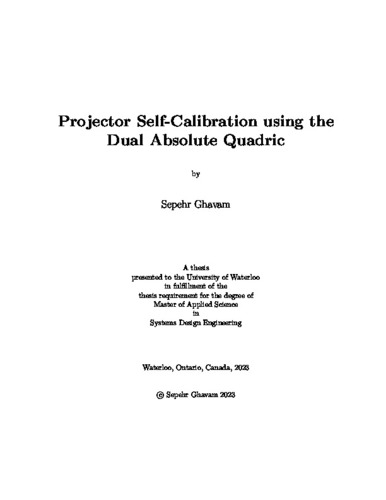| dc.description.abstract | The applications for projectors have increased dramatically since their origins in cinema.
These include augmented reality, information displays, 3D scanning, and even archiving
and surgical intervention. One common thread between all of these applications is the nec-
essary step of projector calibration. Projector calibration can be a challenging task, and
requires significant effort and preparation to ensure accuracy and fidelity. This is especially
true in large scale, multi-projector installations used for projection mapping. Generally,
the cameras for projector-camera systems are calibrated off-site, and then used in-field un-
der the assumption that the intrinsics have remained constant. However, the assumption
of off-site calibration imposes several hard restrictions. Among these, is that the intrinsics
remain invariant between the off-site calibration process and the projector calibration site.
This assumption is easily invalidated upon physical impact, or changing of lenses. To ad-
dress this, camera self-calibration has been proposed for the projector calibration problem.
However, current proposed methods suffer from degenerate conditions that are easily en-
countered in practical projector calibration setups, resulting in undesirable variability and
a distinct lack of robustness. In particular, the condition of near-intersecting optical axes
of the camera positions used to capture the scene resulted in high variability and significant
error in the recovered camera focal lengths. As such, a more robust method was required.
To address this issue, an alternative camera self-calibration method is proposed. In this
thesis we demonstrate our method of projector calibration with unknown and uncalibrated
cameras via autocalibration using the Dual Absolute Quadric (DAQ). This method results
in a significantly more robust projector calibration process, especially in the presence of
correspondence noise when compared with previous methods. We use the DAQ method
to calibrate the cameras using projector-generated correspondences, by upgrading an ini-
tial projective calibration to metric, and subsequently calibrating the projector using the
recovered metric structure of the scene. Our experiments provide strong evidence of the
brittle behaviour of existing methods of projector self-calibration by evaluating them in
near-degenerate conditions using both synthetic and real data. Further, they also show that
the DAQ can be used successfully to calibrate a projector-camera system and reconstruct
the surface used for projection mapping robustly, where previous methods fail. | en |

